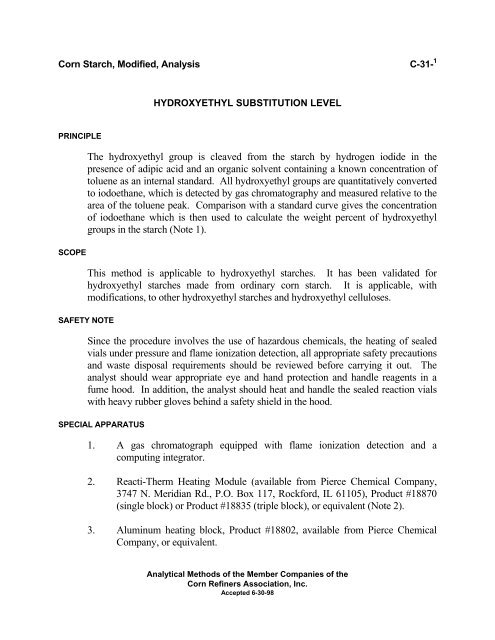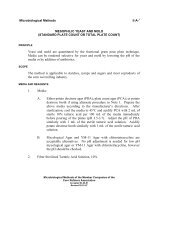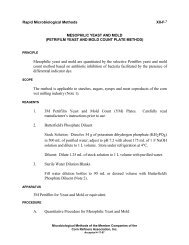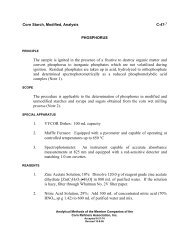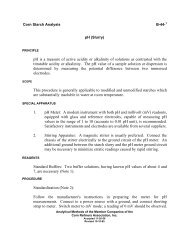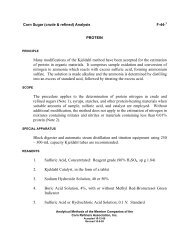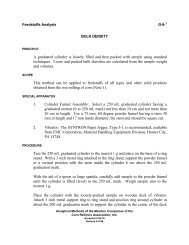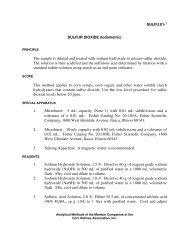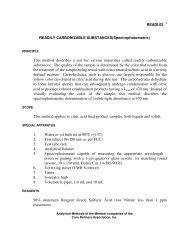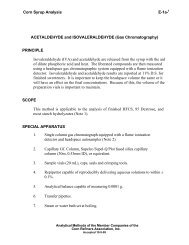The hydroxyethyl group is cleaved from the starch by hydrogen ...
The hydroxyethyl group is cleaved from the starch by hydrogen ...
The hydroxyethyl group is cleaved from the starch by hydrogen ...
Create successful ePaper yourself
Turn your PDF publications into a flip-book with our unique Google optimized e-Paper software.
Corn Starch, Modified, Analys<strong>is</strong> C-31- 1HYDROXYETHYL SUBSTITUTION LEVELPRINCIPLESCOPE<strong>The</strong> <strong>hydroxyethyl</strong> <strong>group</strong> <strong>is</strong> <strong>cleaved</strong> <strong>from</strong> <strong>the</strong> <strong>starch</strong> <strong>by</strong> <strong>hydrogen</strong> iodide in <strong>the</strong>presence of adipic acid and an organic solvent containing a known concentration oftoluene as an internal standard. All <strong>hydroxyethyl</strong> <strong>group</strong>s are quantitatively convertedto iodoethane, which <strong>is</strong> detected <strong>by</strong> gas chromatography and measured relative to <strong>the</strong>area of <strong>the</strong> toluene peak. Compar<strong>is</strong>on with a standard curve gives <strong>the</strong> concentrationof iodoethane which <strong>is</strong> <strong>the</strong>n used to calculate <strong>the</strong> weight percent of <strong>hydroxyethyl</strong><strong>group</strong>s in <strong>the</strong> <strong>starch</strong> (Note 1).Th<strong>is</strong> method <strong>is</strong> applicable to <strong>hydroxyethyl</strong> <strong>starch</strong>es. It has been validated for<strong>hydroxyethyl</strong> <strong>starch</strong>es made <strong>from</strong> ordinary corn <strong>starch</strong>. It <strong>is</strong> applicable, withmodifications, to o<strong>the</strong>r <strong>hydroxyethyl</strong> <strong>starch</strong>es and <strong>hydroxyethyl</strong> celluloses.SAFETY NOTESince <strong>the</strong> procedure involves <strong>the</strong> use of hazardous chemicals, <strong>the</strong> heating of sealedvials under pressure and flame ionization detection, all appropriate safety precautionsand waste d<strong>is</strong>posal requirements should be reviewed before carrying it out. <strong>The</strong>analyst should wear appropriate eye and hand protection and handle reagents in afume hood. In addition, <strong>the</strong> analyst should heat and handle <strong>the</strong> sealed reaction vialswith heavy rubber gloves behind a safety shield in <strong>the</strong> hood.SPECIAL APPARATUS1. A gas chromatograph equipped with flame ionization detection and acomputing integrator.2. Reacti-<strong>The</strong>rm Heating Module (available <strong>from</strong> Pierce Chemical Company,3747 N. Meridian Rd., P.O. Box 117, Rockford, IL 61105), Product #18870(single block) or Product #18835 (triple block), or equivalent (Note 2).3. Aluminum heating block, Product #18802, available <strong>from</strong> Pierce ChemicalCompany, or equivalent.Analytical Methods of <strong>the</strong> Member Companies of <strong>the</strong>Corn Refiners Association, Inc.Accepted 6-30-98
Corn Starch, Modified, Analys<strong>is</strong> C-31- 2HYDROXYETHYL SUBSTITUTION LEVEL Χ continuedREAGENTS4. Reacti-Vials, 5.0 mL capacity, Product #13223 with open top screw caps andTuf-Bond D<strong>is</strong>cs (Product #12718), available <strong>from</strong> Pierce Chemical Company,or equivalent (Note 3).5. Pipets, 2 mL TD.1. Mixed Xylenes, ACS reagent grade, free of toluene, Aldrich cat #44,337-9, orequivalent. Check for <strong>the</strong> absence of toluene <strong>by</strong> running a blank <strong>by</strong> gaschromatography.2. Iodoethane (ethyl iodide), 99%.3. Toluene, ACS reagent grade.4. Internal Standard Solution: 5 mg/mL toluene in xylene. Weigh 5.00 ± 0.01 gtoluene and dilute to 1 L with xylene.5. Standard Stock Solution: Tare a 25 mL volumetric flask with glass stopper.Add 1 mL of iodoethane to <strong>the</strong> flask. Reweigh to determine <strong>the</strong> amount ofiodoethane in <strong>the</strong> flask. Dilute to volume with <strong>the</strong> internal standard solution.6. Hydriodic acid, 57%: A high purity constant boiling acid (HI) of specificgravity 1.7 must be used. Available <strong>from</strong> G. Frederick Smith Co., 867Mckinley Avenue, Columbus, OH 43223.7. Adipic acid, mp 151-153 °C .8. Gas Liquid Chromatographic Column: Stainless steel, 10 ft x 1/8 inch, packedwith 10% SP2100 on 80/100 mesh Chromosorb W-HP <strong>is</strong> suggested (available<strong>from</strong> Supelco, Supelco Park, Bellefonte, PA 16823-0048). O<strong>the</strong>r non-polarmethyl silicones can be used but <strong>the</strong> chromatographic parameters given hereare for SP2100 (Notes 2 & 3).
Corn Starch, Modified, Analys<strong>is</strong> C-31- 3HYDROXYETHYL SUBSTITUTION LEVEL Χ continuedCHROMATOGRAPH PARAMETERS1. Column Temperature: 100 °C2. Injector Port Temperature: 180 °C3. Detector Temperature: 250 °C4. Gas Flow Rates: Nitrogen 20 mL/min.PROCEDUREStandardization: Pipet 0.6 mL of <strong>the</strong> standard stock solution into a 25 mL glass vial.Add 7.4 mL of <strong>the</strong> internal standard solution and mix. Pipet 1.0 mL of <strong>the</strong> solutioninto a 5 mL Reacti-Vial, add 2 mL of hydriodic acid and 150 mg of adipic acid. Mixand inject 1.0μL of <strong>the</strong> upper (xylene) layer into <strong>the</strong> gas chromatograph.Determine <strong>the</strong> area of <strong>the</strong> toluene peak and <strong>the</strong> iodoethane peak. Calculate <strong>the</strong>amount of iodoethane in <strong>the</strong> standard using <strong>the</strong> following calculation:iodoethane,mLmg(wt iodoethane, mg)(0.6)=(25)(8)Determine <strong>the</strong> amount of ethylene oxide using <strong>the</strong> following formula:mg ethyleneoxide (mg iodoethane)(44.05)=mL(mL)(155.97)Th<strong>is</strong> solution will also contain 5.0 mg of toluene per mL.Determine <strong>the</strong> response factor (RF) using <strong>the</strong> following formula:(iodoethane, mg)(area of internal standard)RF =(area of iodoethane)(internal standard, mg)where <strong>the</strong> weight of <strong>the</strong> internal standard <strong>is</strong> 5.0 mg and <strong>the</strong> weight of iodoethane wascalculated above (equation 1).
Corn Starch, Modified, Analys<strong>is</strong> C-31- 4HYDROXYETHYL SUBSTITUTION LEVEL Χ continuedWash and dry a representative sample of <strong>starch</strong> (Note 4 & 5). Accurately weighabout 80 mg (± 3) d.b. of <strong>starch</strong> and transfer to a 5 mL Reacti-Vial. Add 150 mg ofadipic acid. Add 2 mL (using a 2 mL TD pipet) of mixed xylenes which contains 5.0mg/mL of toluene, followed <strong>by</strong> 2.0 mL of hydriodic acid. Wrap <strong>the</strong> threads of <strong>the</strong>vial with teflon tape and cap <strong>the</strong> vial. Weigh <strong>the</strong> vial. Heat <strong>the</strong> vial at 150 ° C for 3.5hrs., inverting it every 10 min. during <strong>the</strong> first hr. and every 40 mins. <strong>the</strong>reafter. Coolto room temperature and reweigh <strong>the</strong> vial. If <strong>the</strong> vial has lost less than 50 mg,centrifuge it at about 800 rpm for 10 mins. Vials with a weight loss of more than 50mg should be rejected and <strong>the</strong> analys<strong>is</strong> repeated. Inject 1.0 μL of <strong>the</strong> xylene (upper)layer into <strong>the</strong> gas chromatograph. Determine <strong>the</strong> areas of <strong>the</strong> internal standard andiodoethane.CALCULATIONmg iodoethane =(area iodoethane)(wt internal standard) R .F.(area internal standard)% ethylene oxide =(44.05)(mg iodoethane)(100)(155.97)(sample weight d .b.(mg))NOTES AND PRECAUTIONS1. Th<strong>is</strong> method <strong>is</strong> derived <strong>from</strong> <strong>the</strong> classical Ze<strong>is</strong>el procedure (CRA method C-30). As originally developed, <strong>the</strong> d<strong>is</strong>tillation method <strong>is</strong> d<strong>is</strong>cussed in reference1. A more complete d<strong>is</strong>cussion <strong>is</strong> found in reference 4.2. <strong>The</strong> single block heating module will heat form ambient temperature to 150°C (temperature control: ±0.5 °C). <strong>The</strong> triple block heating module can beoperated to 200 °C. Both are also available with magnetic stirring capability,respectively, as products #18970 and #18935.3. <strong>The</strong> Tuf-Bond d<strong>is</strong>c <strong>is</strong> designed to provide for good seal/reseal and adequateres<strong>is</strong>tance to pressure. However, publ<strong>is</strong>hed information in References 2 and 4below was obtained after combining open caps with Mininert7 Valves (Piercecatalogue #10127). Use of closed caps <strong>is</strong> less convenient: vials need to beopen for sampling and injection into GC. Also, holding open vial for multipleinjections could cause loss of alkyl iodide.
Corn Starch, Modified, Analys<strong>is</strong> C-31- 5HYDROXYETHYL SUBSTITUTION LEVEL Χ continuedREFERENCES4. <strong>The</strong> gas chromatographic conditions for different liquid phases such as OV-101 (a dimethyl silicone) and UCW 98 (a methyl silicone) should bedetermined <strong>by</strong> experimentation.5. Hydriodic acid degrades some of <strong>the</strong> <strong>starch</strong> and materials <strong>from</strong> <strong>the</strong> reactionare deposited on <strong>the</strong> column. <strong>The</strong> column should be cleaned <strong>by</strong> heating it to180 °C for at least three hrs.6. Ethylene glycol may be present as a <strong>by</strong>-product of manufacturing <strong>the</strong> <strong>starch</strong>derivative and could form iodoethane, <strong>the</strong>refore should be removed <strong>by</strong>washing with water.7. <strong>The</strong> <strong>starch</strong> could be dried essentially to zero mo<strong>is</strong>ture, but it may be used as <strong>is</strong>after determining mo<strong>is</strong>ture <strong>by</strong> an approved method.1. Lortz, H. J., Anal. Chem., 28, 892-895 (1956).2. Hodges, K. L., Kester, W. E., Wiederrich, D. L. and Grover, J. A., Anal.Chem., 51,2172- 2176 (1979).3. West, I. R., Hedges, A. R., Owen, R. L. and Yahl, K. R., American MaizeProducts Company, unpubl<strong>is</strong>hed report (1982).4. Lee, Y. Baaske, D. M. and Carter, J. E., Anal. Chem., 55, 334-338 (1983).


